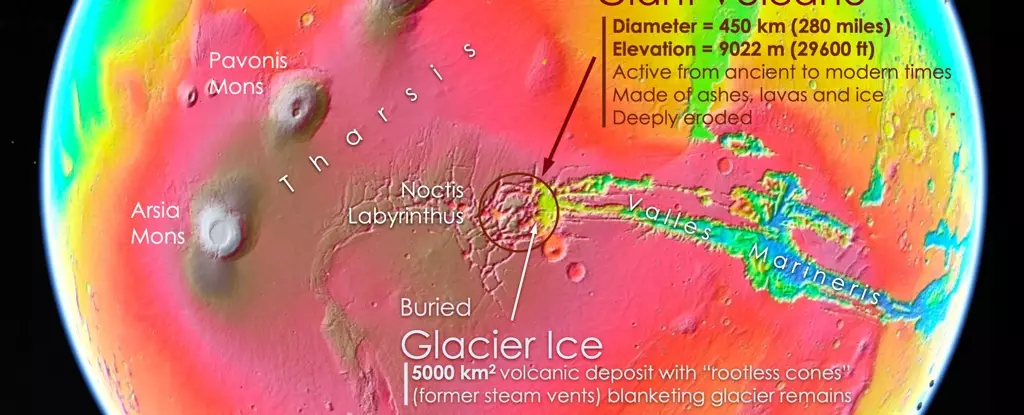In the desolate expanse of Mars lies a well-kept secret waiting to be discovered. Beneath the rugged region known as Noctis Labyrinthus, scientists have stumbled upon evidence of a colossal ancient volcano, accompanied by the possibility of entombed glacier ice. This unexpected revelation has turned the equatorial site into a promising candidate for unearthing traces of ancient life on the arid and barren planet. The identifying of a concealed volcano was never part of the initial plan, yet when a group led by planetary scientist Pascal Lee of the SETI Institute scrutinized a zone marked with remnants of an ancient glacier, they discerned the presence of an overlooked volcano – one that could easily be mistaken due to heavy erosion. The volcano, tentatively named Noctis Mons, had remained camouflaged for decades, only to be recently exposed, sparking excitement within the scientific community.
Noctis Mons stands as a monumental structure, reaching a height of over 9,000 meters and stretching its base across 250 kilometers. This elevates Noctis Mons to being the seventh highest topographical feature on Mars. The presence of distinct features further solidifies the volcanic nature of the mountain. Researchers identified the remains of a caldera near the center – a collapsed crater that once harbored a pool of lava. The central region is also dotted with mesas forming an arc shape, outlining the conical structure of the volcano that slopes into surrounding lava fields. Volcanic deposits scattered across several points provide further evidence of the volcano’s long-term activity. Noteworthy discoveries such as rootless cones, indicative of volcanic terrains, suggest the potential presence of glacial ice buried beneath the surface. The interplay of thermal erosion, glacial erosion, and fracturing over extended periods has sculpted the landscape into its current form.
The revelation of a potential buried sheet of glacier ice beneath Noctis Labyrinthus adds a new layer of intrigue to the exploration of Mars. The coexistence of warmth and water from remnants of glacial ice could create favorable conditions for the emergence of life. The long history of heat interacting with water and ice makes the site a prime location for astrobiological studies, offering a glimpse into Mars’ evolution through time. The presence of glacier ice in a relatively warm equatorial region on Mars enhances the allure of Noctis Labyrinthus for both robotic and human exploration. The possibility of ongoing volcanism and seismic activity on Mars hints at a dynamic geological landscape that could potentially harbor even more surprises beneath the surface.
The recent findings presented at the 55th Lunar and Planetary Science Conference have opened up new avenues for research and exploration on Mars. The unique combination of geological features at the Noctis volcano site presents an exciting opportunity to delve into Mars’ past and understand its geological evolution. The potential presence of buried glacier ice underscores the importance of further exploration to unlock the secrets hidden beneath the surface of the Red Planet. As we continue to uncover the mysteries of Mars, the discoveries at Noctis Labyrinthus stand as a testament to the vast and diverse landscapes that await exploration in our neighboring planet.



Leave a Reply